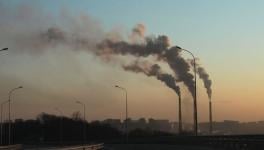It’s Air Pollution Time… Yet Again!
It would be humorous if it was not so tragic, but it is another winter in Delhi and North India as a whole, and has brought with it, yet again, another prolonged spell of terrible air pollution.
The usual media commentaries have been appearing, providing partial explanations for the pollution, its many causes and the possible impacts of the measures being taken to tackle it. As usual, however, none of these measures seem to have brought about the required results -- pollution levels are as high as ever, and even the heavy smog over North India cannot hide the high probability that next year, too, we are likely to face the same situation and only discuss the issue once again without seeing serious action to mitigate the air pollution that is setting world records and making international headlines year after year.
Also, as usual, most media commentaries miss the wood for the trees, get lost in minute details while losing sight of the big picture and the major, effective measures required.
The one relatively brighter side to this otherwise dismal picture is the attention the issue of air pollution is finally getting from political parties, particularly those at the Centre and those governing Delhi and the neighbouring states of Punjab and Haryana, however adequately or mostly inadequately.
Citizens’ groups and organisations are also getting more involved, demanding more action by governments. If the latter trend gets stronger, it will hopefully put greater pressure on the former and bring the agenda of air pollution higher among the priorities of these governing parties.
HIGH BASE LEVEL OF AIR POLLUTION
It is by now well known that winter in North India sees the worst air pollution in the year due to seasonal weather patterns, as well as due to a sharp spike in air pollution caused by burning of paddy crop stubble especially in Punjab and Haryana, and in pockets of western Uttar Pradesh.
What is often forgotten is that these factors sit on top of an unacceptably high base level of air pollution caused by vehicles and dust, not just in Delhi but in all cities and towns in India, as well as from coal-based power plants, industries, generators and various forms of coal and biomass cooking and other combustion.
In summer, warm air rises, taking the air pollutants especially particulates with it, leading to lower levels of pollution near the surface. Winds also work to disperse the pollutants and carry them away.
In peninsular India, generally warmer conditions around the year and sea breezes taking the pollutants out to the sea, result in pollution levels that are consistently lower than in the North Indian plains. Here, in the cold air of winter, pollutants stay low near the surface. In the absence of wind, as at present, or bright sun, this problem is worsened and this “inversion layer” often persists for relatively long periods.
But again, the issue to remember is that the root of the problem is the high base level of air pollution, not stubble burning, not winter inversion or weather trends.
All the major causes listed above are endemic to virtually all towns and cities in India. However, many locations fare far worse than, say Delhi, due to less regulation, lower standards and weaker enforcement.
Vehicular pollution is an extremely high proportion of total air pollution, especially in Delhi, due to the explosive growth of personal vehicles in the past few decades. In most passenger four-wheelers, measures to reduce tailpipe emissions have been mandated through regulations now at BS-VI level from 2020, with BS-VI fuel standards applicable in Delhi. In two-wheelers, more polluting two-stroke engines are no longer permitted in new vehicles. However, large numbers of older vehicles ply on the roads.
In numerous towns and cities, older petrol-driven autorickshaws are common due to paucity of CNG, and many have highly polluting four-or-more seater passenger transport vehicles that are essentially diesel engines mounted on a chassis.
Pressure from the automobile industry delayed many regulatory improvements by several years, such as fuel-efficiency standards (less fuel burned per km travel means less emissions) or measures to reduce diesel vehicles through tax parity with petrol or a compensatory one-time cess on diesel vehicles to offset the fuel price differential. Even now, the automobile industry has also successfully pushed back against the Central government efforts to accelerate a transition to electric cars.
Failure to regulate diesel vehicles has led to their proliferation to the extent that, at one time, almost 50% of passenger vehicles in Delhi were diesel powered! Diesel vehicles emit not only more particulates but also more toxic nitrogen dioxides and other carcinogens. London, for example, found, much to its consternation, that it was performing below European air pollution standards only because of its iconic diesel-powered red double-decker buses!
It is well known, and therefore widely practiced in more advanced cities and countries abroad, that a major solution is to reduce the number of passenger vehicles on the roads and provide convenient and accessible mass public transport by metro-rail, buses, other surface rail systems etc., alone or in combination depending on city size.
Provision also needs to be made, especially in road design and construction, to encourage non-motorised transportation by bicycle, for example, and for pedestrians. Here again, India has failed miserably.
Take Delhi, where about 15,000 buses are required but only 4,000-odd are available, and where the many thousands of kilometers of roads are made just with motorised transport in mind. While many European cities have made public transport free or with very low fares, the Delhi Metro and the central government insist on high fares, thereby keeping ridership much lower than it can be. The situation in other cities, including many state capitals, is far worse with non-existent mass public transport.
Then there are diesel generators, widely used in India due to unreliable electricity supply, but fortunately banned in Delhi where power supply is more steady these days. Coal-based power plants mostly do not meet stack emission standards, have not taken necessary measures to ensure the same, and there is no enforcement worth the name.
Road dust, from unregulated construction activity and from poor design and construction of roads with open dust parts on either side, and no sprinkling of water to keep dust down, is another major problem. Green spaces, avenue trees and other such urban commons accessible to all citizens are important measures to combat pollution while improving the quality of life. The small city state of Singapore with defined national boundaries on all sides has managed to preserve 40% of its land area as green spaces and urban commons.
The main question that should be asked of governments at all levels and municipalities is how is it that cities in Europe and elsewhere maintain air pollution at levels close to if not conforming to World Health Organisation standards while India fails so miserably at this task. The answer is, it is not one reason or another, but a complete and systemic failure of governance at all levels and in all spheres, whether regulation, monitoring or enforcement. There can be no short cuts to this.
The National Clean Air Programme announced by the Centre in early 2019 has an extremely weak and timid target of reducing particulate air pollutants by 20-30 per cent by 2024 compared with 2017 levels, and other measures focusing on a mere 100 cities. Compare this to current air pollution levels in most of North India which are up to 18 times the WHO norm! Or compare this with Beijing’s success, from a Delhi-like situation less than a decade ago, in reducing air pollutants by 25-83% depending on the pollutant, and reducing PM2.5 by 35%, all between 2013 and 2017, by effectively tackling coal-fired power plants and boilers, and vehicular pollution.
All, repeat all, necessary measures need to be taken effectively and systematically, and all aspects of governance brought to bear, or else air pollution in India will simply not get better.
HALF-MEASURES AND SILVER BULLETS
To its credit, the Delhi government has taken many steps that help tackle air pollution. However, compared with the task at hand, these amount to baby steps. The odd-even scheme during peak pollution time as per the Graded Action Plan of the Supreme Court’s Environment Prevention and Control Authority, is a case in point. The deputy chief minister claimed that since virtually half the vehicles were off the roads, pollution would also have been halved, is quite incorrect. There are simply too many exemptions: cars with women drivers, cars with school children. And, inexplicably, two-wheelers are totally exempt.
Delhi has around 11 million vehicles with around seven million two-wheelers. If car-owners can be persuaded to use the metro or buses on alternate days, why not bike and scooter riders? Is this an admission that Delhi’s public transport system cannot handle this addition? The idea of the odd-even scheme should be to get roughly half of ALL vehicles off Delhi’s roads during peak pollution time, apart from promoting public mass transport so that vehicle owners can leave their cars or two-wheelers at home and commute to work in the former.
Wealthy Singapore has managed to do this even with its middle- or upper-middle classes, and it is common to see this practice in European cities. Why not Delhi and other Indian cities?
At the same time, the Delhi BJP’s opposition to the odd-even scheme is wholly counter-productive and only serves to spread public cynicism. Daily pollution data soon to be released by the Delhi government covering the odd-even period will surely bear this out, for, if not 50%, it would certainly have reduced pollution to some extent.
The issue of stubble burning is, understandably, dominating the headlines these days, but it would be a dire mistake to believe that if stubble burning is halted, or after the winter wheat plantation is done, North India’s pollution woes will end. Citizens should not be misled into believing, as high Delhi government officials are saying, that air pollution levels were at “satisfactory” before stubble burning started, and that therefore this is the only problem.
If Delhi and other parts of North India suffer from adverse conditions due to the winter, so too they benefit from favourable conditions during summer. But the base level of pollution remains high and can always haunt citizens when unfavourable conditions prevail.
The state governments of Punjab and Haryana, as well as Uttar Pradesh, have done precious little to stem the problem of stubble burning. Climate change has also contributed, the paddy harvesting season having been pushed deeper into the winter, leaving a very short window of two weeks or so to harvest the paddy crop and get fields ready for the wheat sowing to follow. Haryana farmers mostly grow basmati rice in six districts, and stubble is less of a problem here because combine harvesters which leave long stubble are rarely used since they damage the grains.
Punjab farmers grow mostly non-basmati rice in all districts because of the ready returns this brings in the form of minimum support price, and combine harvesters are widely used, which is why stubble burning is such a major issue here. Machines such as Happy Seeders and stubble management systems are available but in limited numbers and are priced beyond the reach of most farmers. The state government is trying to give such machines to farmers but, for obvious reasons, this is going very slowly and only about one-tenth of the estimated requirement has been met so far.
Many farmers have said if they were financially compensated for the cost incurred in clearing their fields of stubble, including through ploughing it back into the soil, they would not have to wait for the machines. However, fact is that the two-week window is so short that unless more machines are available in the village or nearby, it would take too long for even hired-in machines to reach each farm, and they would feel pushed towards burning the stubble again.
The Supreme Court, as it tends to do these days, has issued peremptory orders strictly speaking within the purview of the executive, to pay farmers Rs 100 per quintal immediately to “solve the problem,” but will it? At the time of writing, the Punjab government has announced compensation of Rs 2,500 per acre to farmers to refrain from burning stubble. Too little, too late? And the central government is maintaining a studied silence on the entire issue.
These columns have argued before that the problem requires systematic institutional solutions. These could include placing necessary machines in sufficient numbers with local agricultural co-operatives, setting up supply chains for delivering baled stubble to power generating or CNG making plants, more of which should be encouraged to come up, along with commensurate measures under public-private partnerships. Such institutional arrangements are necessary, not simply some machines or doling out cash.
Earlier this week, the Supreme Court has “directed” the Centre and Delhi governments to go abroad and explore possibility of bringing in hydrogen-based fuel cell technology for vehicles! The technology is known, several companies are working on it, but it will take many years to become ready for market.
All this is known. So, what will the SC do next? Start fining the governments if they do not ensure shifting to fuel-cells by next year? All this is like trying to tackle climate change by inventing super-sucker machines which will simply suck out the carbon dioxide from the atmosphere. Some research institutions are experimenting with smaller such machines along Delhi’s roads to ‘clean up” the pollutants. Don’t tackle the root of the problem, just go around it! Keep smoking, but attach a filter!
People should stop looking for silver bullets and science fiction solutions. Air pollution is a systemic problem and needs to be tackled at the roots.
Get the latest reports & analysis with people's perspective on Protests, movements & deep analytical videos, discussions of the current affairs in your Telegram app. Subscribe to NewsClick's Telegram channel & get Real-Time updates on stories, as they get published on our website.
























